Arts & Entertainment Community
Day Tripper | Improved St. Helens visitor center is a blast from the past
May 18, 1980. Does that date sound familiar to you?
It’s been 45 years since that fateful Sunday when Mt. St. Helens blew her top. Each year there are fewer and fewer of us who lived in the Pacific Northwest then and can actually remember the days leading up to and following the volcanic eruption that so dramatically impacted the area, changing the landscape forever.
The Mount St. Helens eruption blasted away part of the mountain and spewed about 540 million tons of ash. According to the United States Geological Survey (USGS), 57 people and thousands of animals died when the mountain blew. The eruption destroyed more than 200 homes and damaged more than 185 miles of roads and 15 miles of railways. The International Trade Commission estimated financial losses at $1.1 billion.
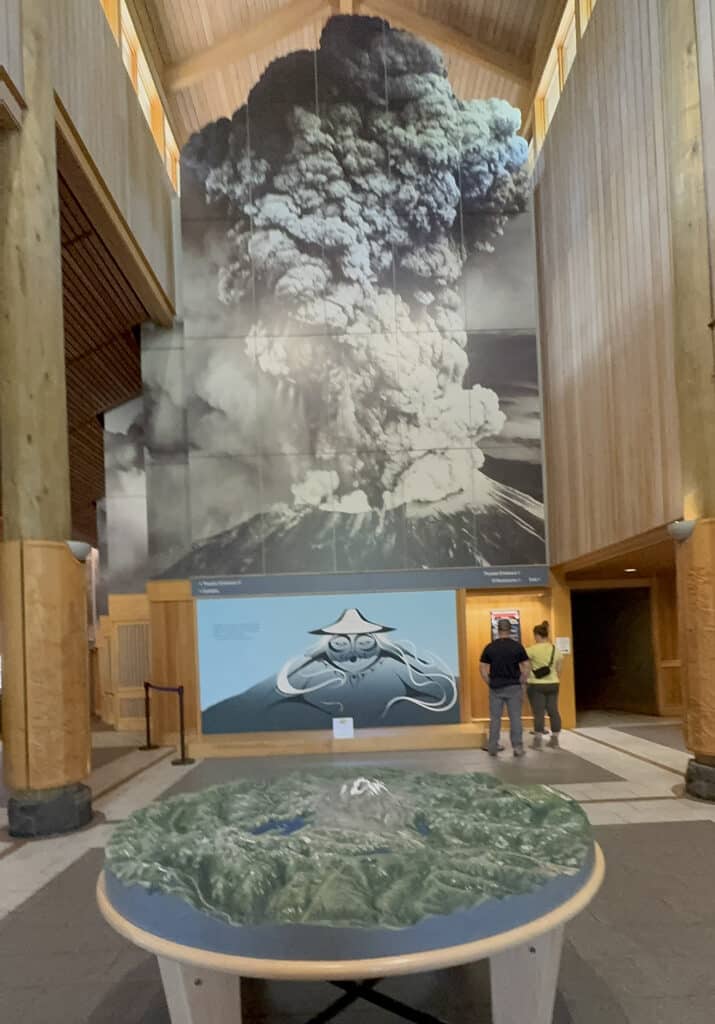
The Mount St. Helens interpretive center. Photo by Mary Williams
Visitor center
On May 31, a new and much improved visitor center reopened after a nine-month closure and massive renovation of the previous building. The center originally opened in 1986, just six years after the mountain erupted. A great deal has been learned since then and much of it is reflected in the exhibits in the new center.
As you arrive at the interpretive center, take a moment to appreciate the natural beauty of the mountain and nearby Silver Lake.
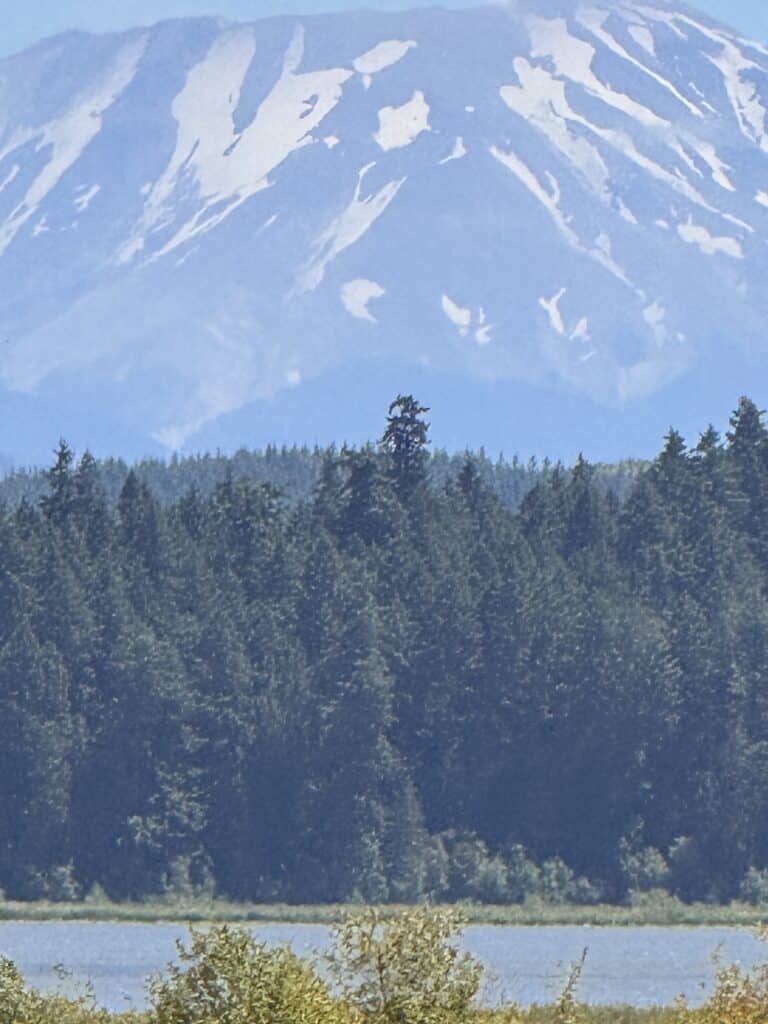
Silver Lake with Mount St. Helens in the background. Photo by Mary Williams
The National Park Service in partnership with the Cowlitz Tribe of Indians developed and funded the $1.1 million renovation. The mountain is integral to the customs and culture of the Cowlitz Tribe and other indigenous people across the region.
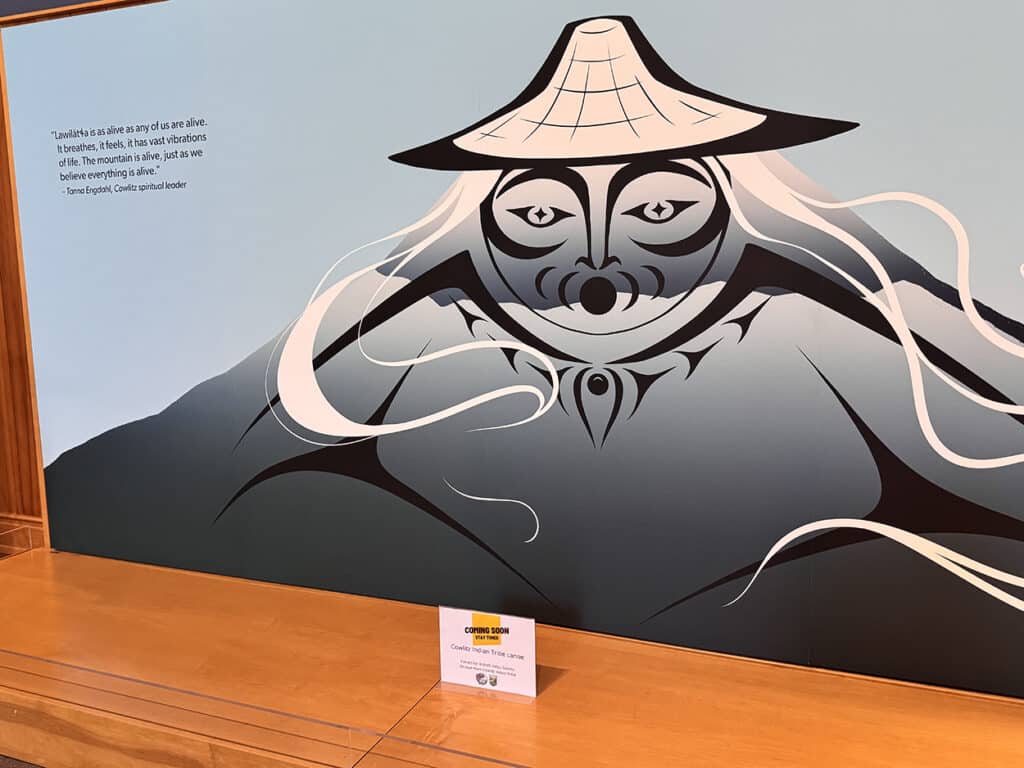
Cowlitz Tribe art on display inside the Mount St. Helens interpretive center. Photo by Mary Williams
New exhibits include contemporary and historic works by Cowlitz artists and feature more tactile, sensory, and interactive exhibits tailored to kids and families.
The building includes a small movie theater with several short films that highlight the tribe’s use of natural resources playing on loop.
New and improved
Exhibits were also updated to reflect current science and to offer an historical perspective of the area’s volcanic action. Many of them demonstrate the power and destruction of the blast. There are also displays honoring some of those who lost their lives, many because they just happened to be in the wrong place at the wrong time.
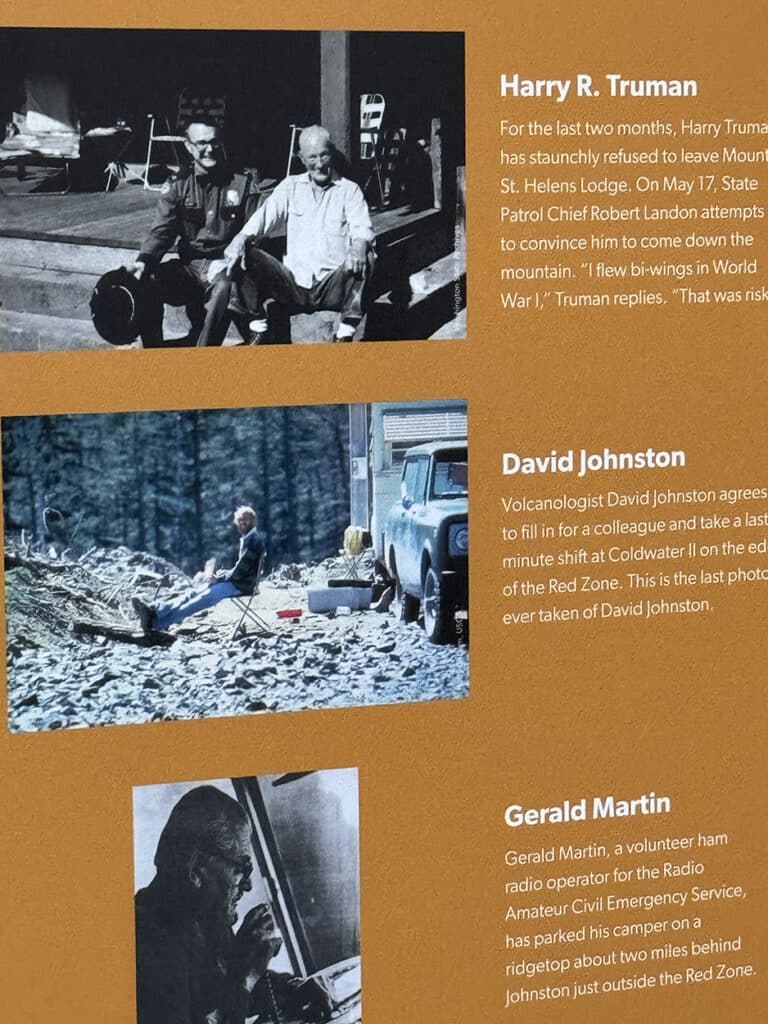
The interpretive center pays tribute to those who died in the eruption. Photo by Mary Williams
There is a new and improved reception area, changes to the buildings’ flow, and more interactive displays and storytelling.
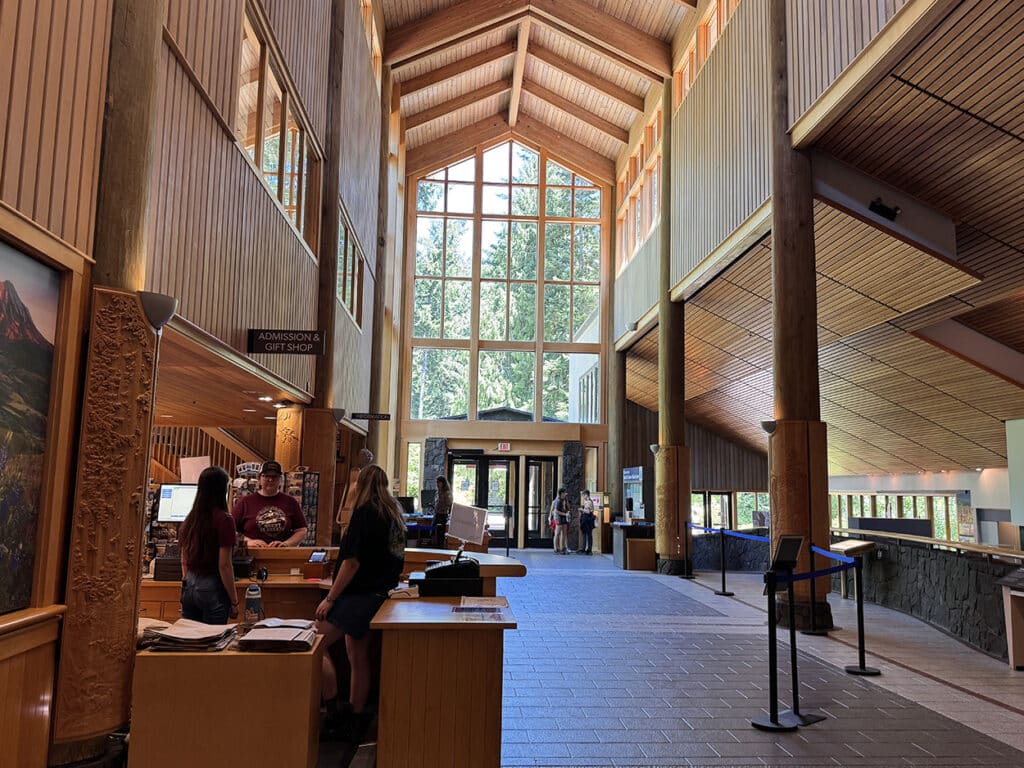
The reception area in the renovated Mount St. Helens interpretive center. Photo by Mary Williams
One new exhibit lets you create your own shockwaves with a seismograph. A walk-through volcano takes you inside a replica of the mountain. There are also historic artifacts, volcanic rocks, a wetland exploration area and a three-dimensional relief map of the mountain.
Everywhere you look are before-and-after photographs that drive home the power of nature still encapsulated in nearby peaks. One exhibit features the remains of a jeep that was parked near the mountain when it erupted.
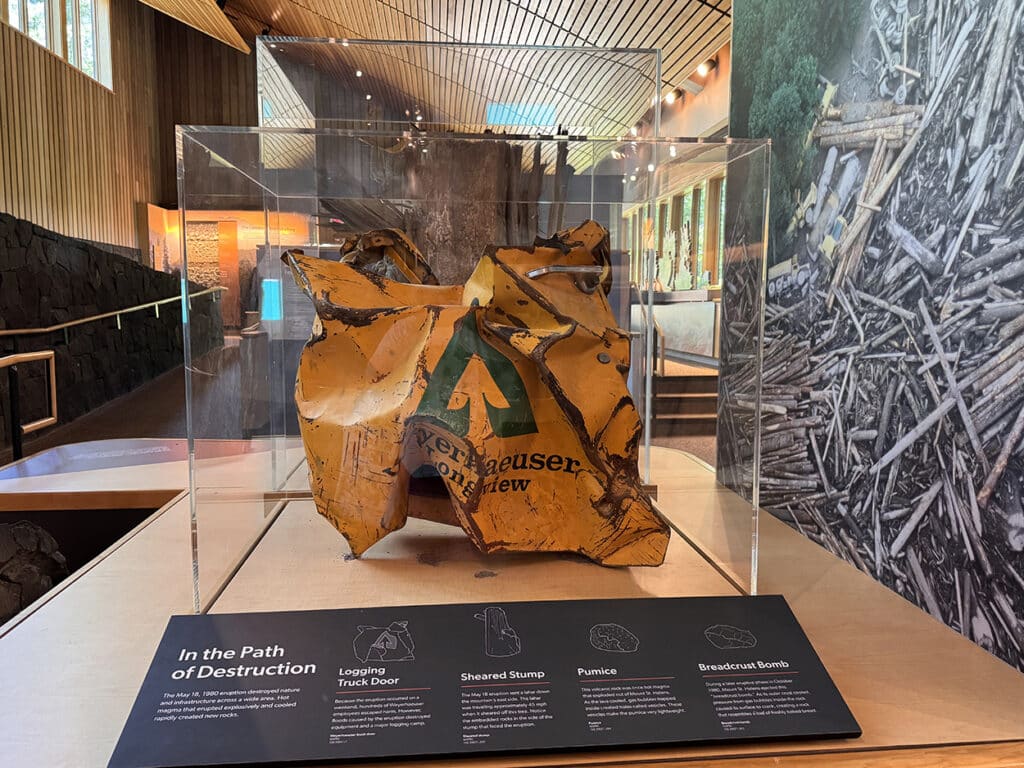
Debris from the eruption in the Mount St. Helens interpretive center. Photo by Mary Williams
There is, of course, the requisite gift shop where you can purchase informational materials, souvenirs and artwork made from the ash. The day I was there a separate room contained artwork and jewelry made by members of the local Cowlitz tribe.
A trip to the new interpretive center comes in just under our self-imposed 100-mile limit at 98.2 miles from Gig Harbor. Head south on I-5 to exit 49 and Castle Rock. The interpretive center is 5 miles east of the interstate on Highway 504. Admission for children under 7 is free. The cost is $2.50 for youth ages 7 to 17 and $5 for adults.
Seaquest State Park
Right across the highway from the entrance to the interpretive center is Seaquest State Park. The interpretive center was built on park land, with a pedestrian tunnel under the highway between the two.
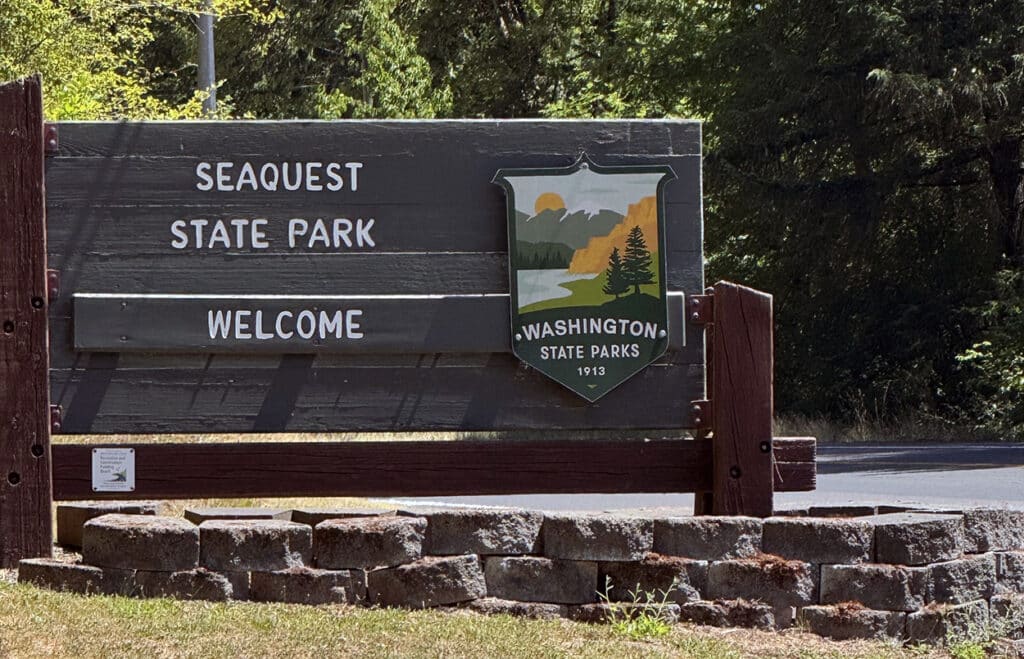
Seaquest State Park is near the Mount St. Helens interpretive center. Photo by Mary Williams
The park offers a variety of recreational activities including tent spots, camper and trailer pads, and a handful of yurts that can be reserved. The yurts are located in a wooded area of the park within walking distance of the Interpretive Center. At 16 feet in diameter and 10 feet high, they’re not exactly spacious. But they do come furnished with a queen-size futon, a bunk bed, end table, electrical outlet and heater. Outside each yurt is a picnic table and fire circle with grate. The yurts are heated, but the park service recommends that campers bring blankets and warm clothing.
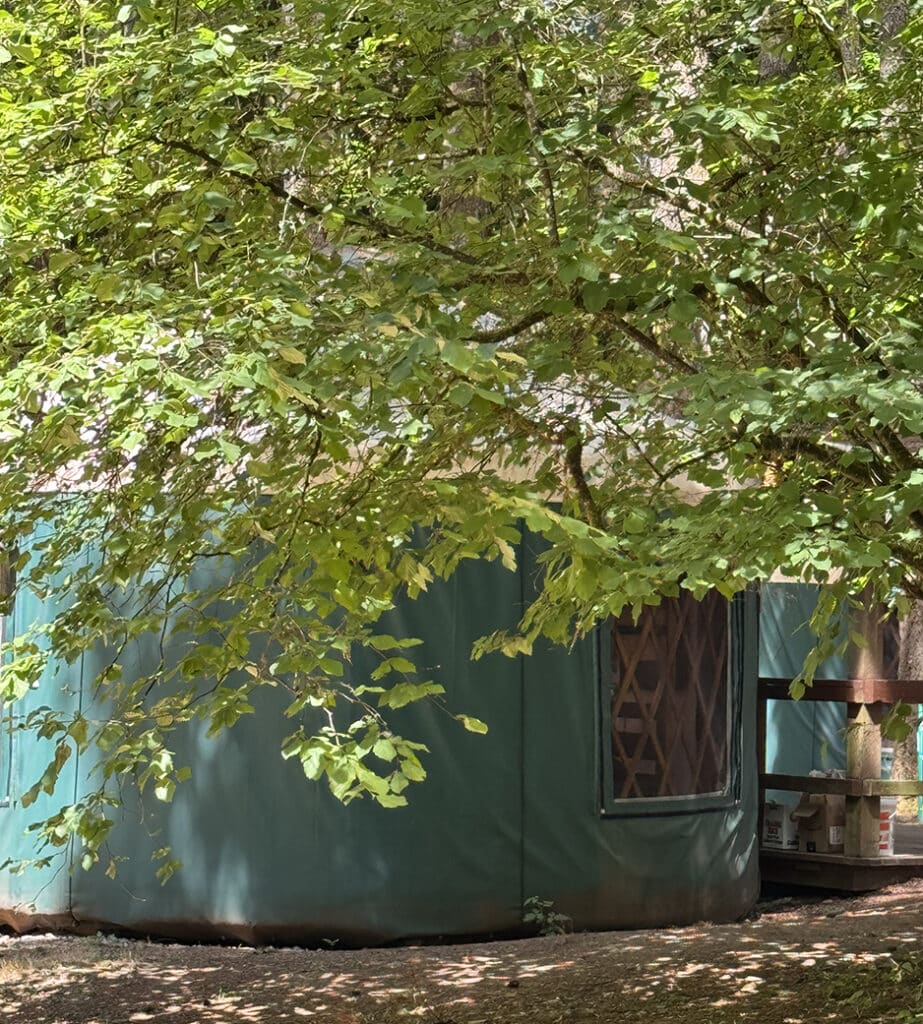
A yurt at Seaquest State Park. Photo by Mary Williams
For more information, check out the Seaquest State Park brochure.
Forty miles further down the road is the Johnston Ridge Observatory, which has been closed since 2023 when landslides damaged State Route 504, the Spirit Lake Outlet Bridge, and the surrounding slope. The slides effectively cut off the only road access to the observatory. The Washington state Department of Transportation hopes to complete the bridge replacement by late summer 2026, but the observatory might not reopen until spring 2027. In the meantime, this 40-plus mile journey is pretty much a beautiful trip to nowhere.
Lewis County
As much as I wanted to check out the new interpretive center, making a 200-mile round trip for a 2-hour visit didn’t sit well with me. So I decided I would also investigate Centralia and Chehalis while passing through Lewis County. They made for a pair of easy and interesting side-trips and a nice diversion.
Both communities share a common early history. Like most towns in the Pacific Northwest, the earliest settlers were members of local tribes. In this area, they were primarily settlements of bands of the Upper Chehalis and Cowlitz Indians. Typically, the settlements were along banks of the rivers that formed early transportation corridors.
Chehalis
The first white settlers at the confluence of the Chehalis and Newaukum Rivers were Schuyler and Eliza Saunders. They built a farm on land they would later claim under the Donation Land Act of 1850. Later, the family of Obadiah B. McFadden, chief justice of the territorial Supreme Court, and his wife Margaret would buy the southern half of the Saunders’ claim. The house they built on their land still stands and is the oldest structure in Lewis County.
Built in 1859 of squared logs, the house at 475 Southwest Chehalis Ave. is the oldest residence in Chehalis. It is also believed to be the oldest continuously lived-in residence in Washington. The building was listed on the National Register of Historic Places in 1975.
Claquato was the first seat of Lewis County. In 1874, the county seat moved from Claquato to Chehalis, primarily because the residents of Chehalis were willing to pay $2,000 of the $3,000 needed to build a county courthouse while the Claquato community could not.

The Lewis County Courthouse in Chehalis. Photo by Mary Williams
Several museums that highlight motorcycles, veterans and military history, and the history of railroads in Lewis County, are located within the city limits. The city has several distinct historical areas and 11 locations on the National Register of Historic Places.
Historical museum
Since I am particularly intrigued by the idiosyncrasies of an area, it was good that my first stop was at the original Chehalis Depot, adjacent to the railroad tracks. Not only is it one of the locations on the National Register of Historic Places, it’s now home to the Lewis County Historical Museum.
Right there in the parking lot is a map of the community showing the many places of interest you might want to visit while you’re in town. The large billboard-sized map has activities worth seeing and locations worth visiting prominently displayed. Each includes a brief description accompanied by a QR code that you can scan to get some historical perspective about why checking out that particular place is worth it. If you want to quickly zip around the town seeing what there is to see, this map is really helpful for route planning.
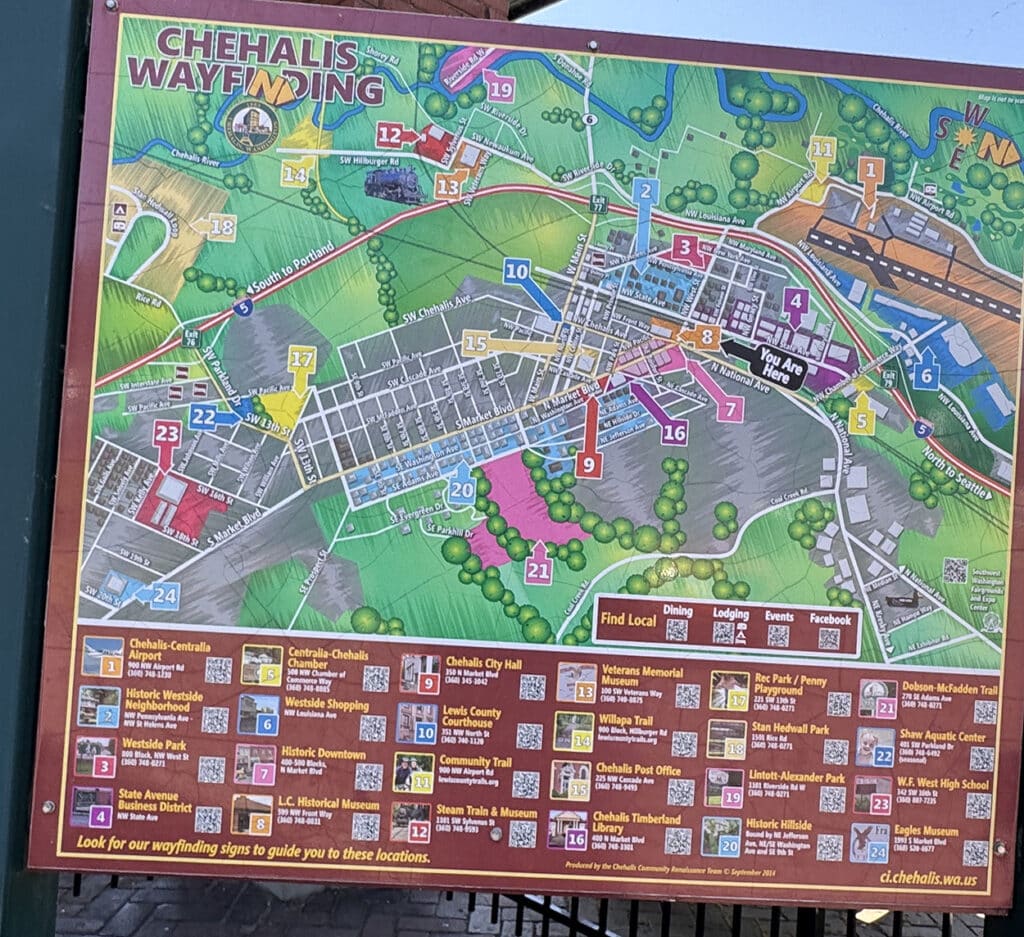
A wayfinding sign at the Lewis County History Museum in Chehalis. Photo by Mary Williams
The map provides two dozen options, each accompanied by a brief description of what you’ll find when you arrive there.
The museum itself houses many of the normal things you might expect to find at most local museums. There are permanent displays featuring life in the early 20th century including replicas of a blacksmith shop, a country store and a post office.
There are some cool things right there in the parking lot area. Yardbirds was part of a small retail chain of mini-megastores similar to Tacoma’s B&I. Home Depot acquired the chain in 2005 and closed it for renovations. Home Depot reopened it in 2007 as a Yardbirds store. It permanently closed in 2009, but the very last of it was liquidated just this spring. The museum acquired one of the tin blackbirds that was the store’s mascot for decades.
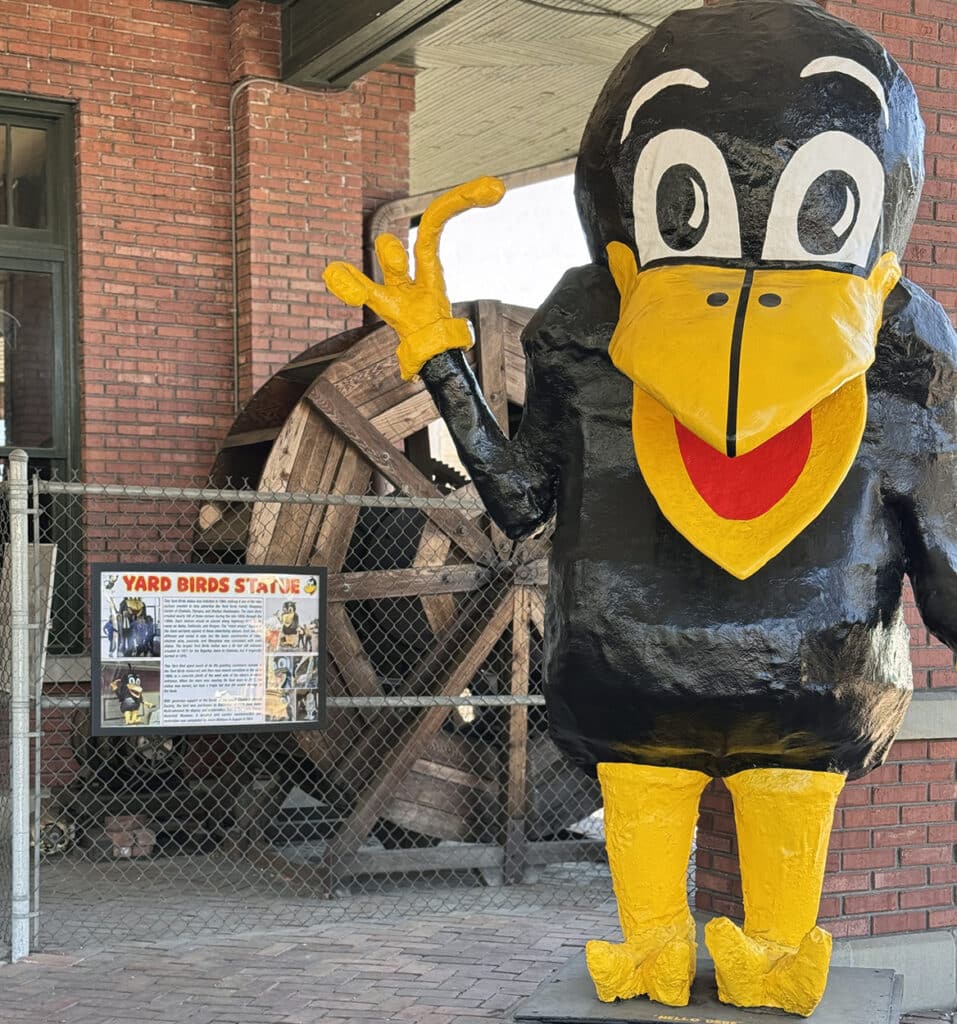
The Yardbird statue at the Lewis County History Museum in Chehalis. Photo by Mary Williams
Stumped
The parking lot also features a replica of the protected McKinley Stump. Once upon a time, it was a giant Douglas fir that grew near Pe Ell. The original tree is said to have produced enough wood to build several modern homes, more than 30,000 board feet of lumber. At one time, it stood more than 300 feet tall. It was estimated to be more than 360 years old when it was felled in May 1901.
The stump was moved several times before ending up in its final resting spot, Chehalis’s Recreation Park. Unfortunately, the final attempt to move it to the museum proved to be too much for it. Wood rot and insect and ant infestations caused it to disintegrate. The Weyerhaeuser Company created a replica and donated it to the city for display at the museum.
Many of the old buildings are still in use. City and county services have offices in buildings that have been maintained or renovated displaying the town’s architectural heritage.
The historical downtown area features many turn-of-the-century examples of the large brick structures built in that era.
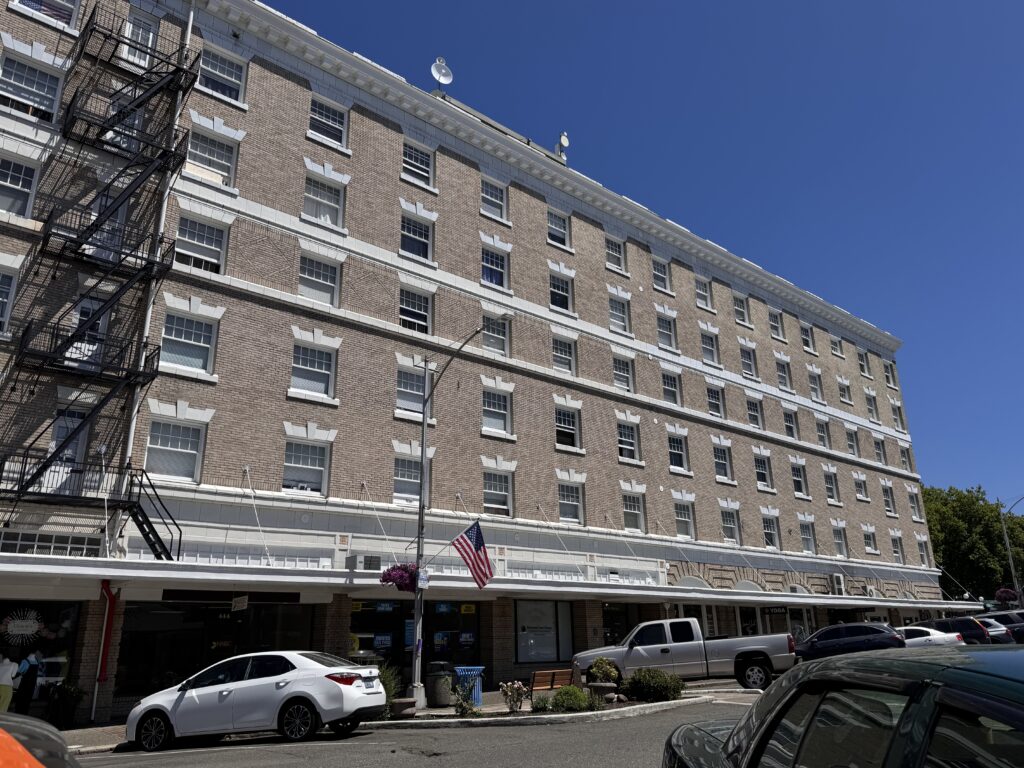
Historic downtown Chehalis. Photo by Mary Williams
Post Office
Mr. and Mrs. Saunders established the first post office in Saunders Prairie, as Chehalis was known at the time, in their Main Street home. The Legislature officially changed the town’s name in 1879.
The early postal service in the area was an on-again, off-again endeavor. After Elizabeth Saunders retired, Mary McFadden, wife of pioneer Obadiah McFadden, oversaw operations, also from her home. Mary’s service was short-lived, and Obadiah became the new postmaster later in the year. The Chehalis post office system has seen continuous, uninterrupted service since then.
The post office relocated several more times before finally settling into its permanent home at the intersection of Cascade Avenue and Center Street. The cost of construction came in $100 under budget at $97,400.
Originally designed as a one-story colonial, the final structure ended up being a two-story red brick building constructed on a raised basement. The symmetrical architectural style is considered Georgian Revival typical of the end of the Beaux-Arts period.
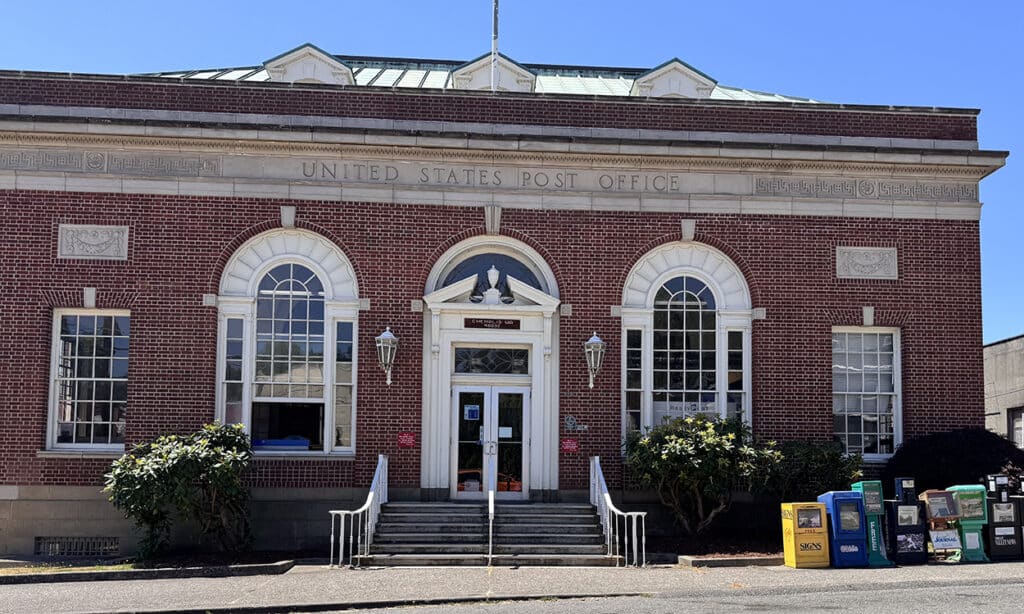
The Chehalis Post Office. Photo by Mary Williams
Centralia
The Centralia Downtown District has been the cornerstone of community life since it was platted in 1885. The Downtown Historic District is on the National Register of Historic Places. In addition, the State Register of Historic Places has also recognized many buildings in the downtown area.
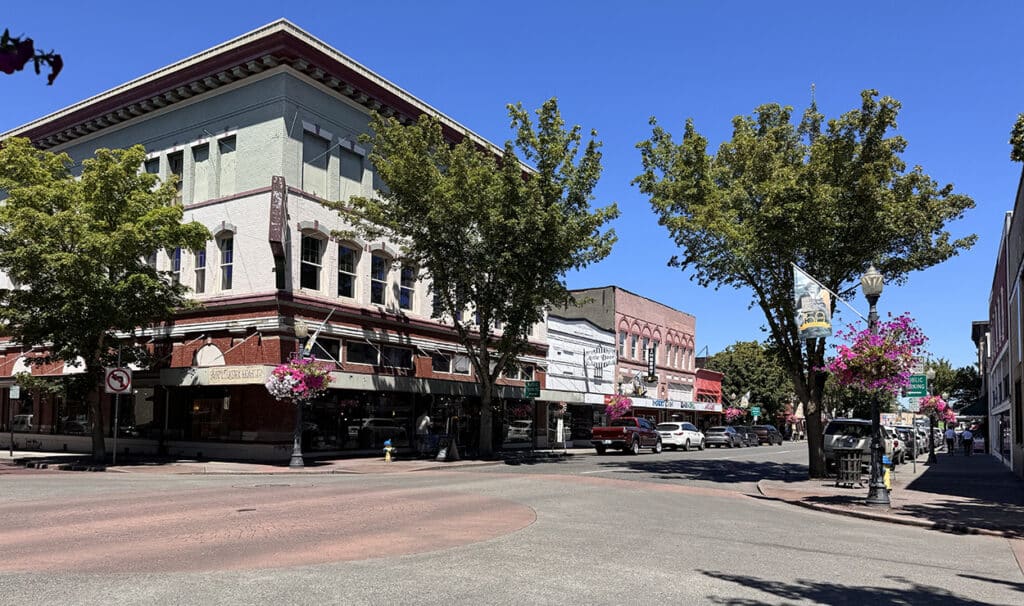
Buildings in downtown Centralia. Photo by Mary Williams
The closet historian of the eclectic in me loves any McMenamins establishment. We visited the Elks Temple in Tacoma in February.
McMenamins is known for revitalizing historic pubs, hotels, restaurants, and entertainment venues. Their commitment to community, art, and preserving local history is demonstrated by their preservation of their properties by using murals, paintings, and other artistic elements. They also host events and concerts and offer spaces for community gatherings.
I was thinking maybe I would revert to my tendency to want to push my limits by venturing 20 miles south of Castle Rock to McMenamins Kalama Harbor Lodge. I found that wasn’t necessary because I discovered The Olympic Club in Centralia, which is also a McMenamins property.
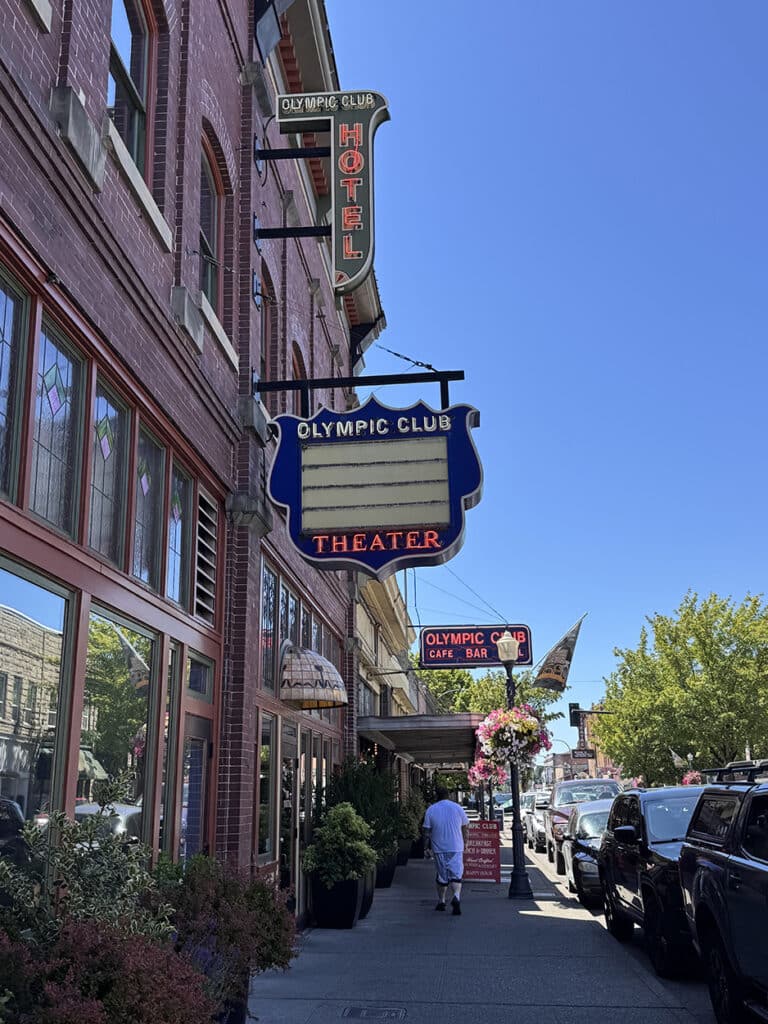
McMenniman’s Olympic Club in downtown Centralia. Photo by Mary Williams
Originally known as the Oxford Hotel when built in 1908, the facility initially contained a bar and pool hall. In 1913, it was severely damaged in a fire but was rebuilt and reopened a year or two later. McMenamins purchased the place in 1996, reopening it as the Olympic Club a year later. A 2002 remodel included the addition of a movie theater.
The Olympic Club contains original vintage decor. A mahogany bar is decorated with original Tiffany-style stained glass lamps and two antique cash registers.
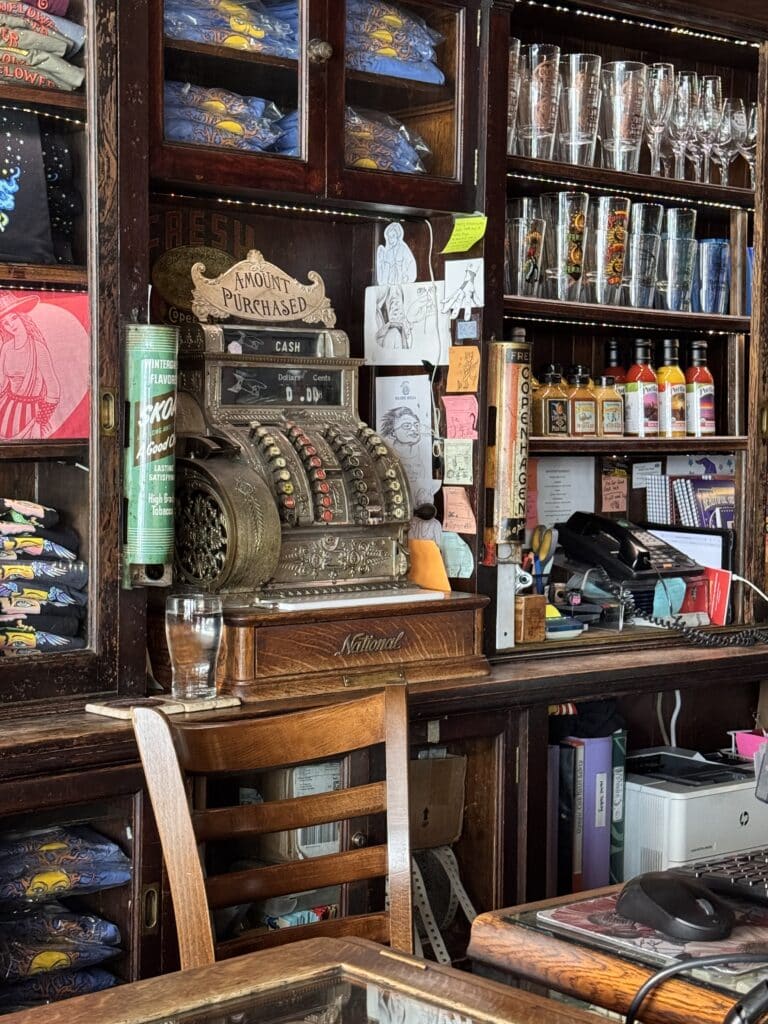
An antique cash register at the Olympic Club in Centralia. Photo by Mary Williams
The dining and pool hall areas contain the original Olympic Club pool tables, an outdoor patio, and a brewery.
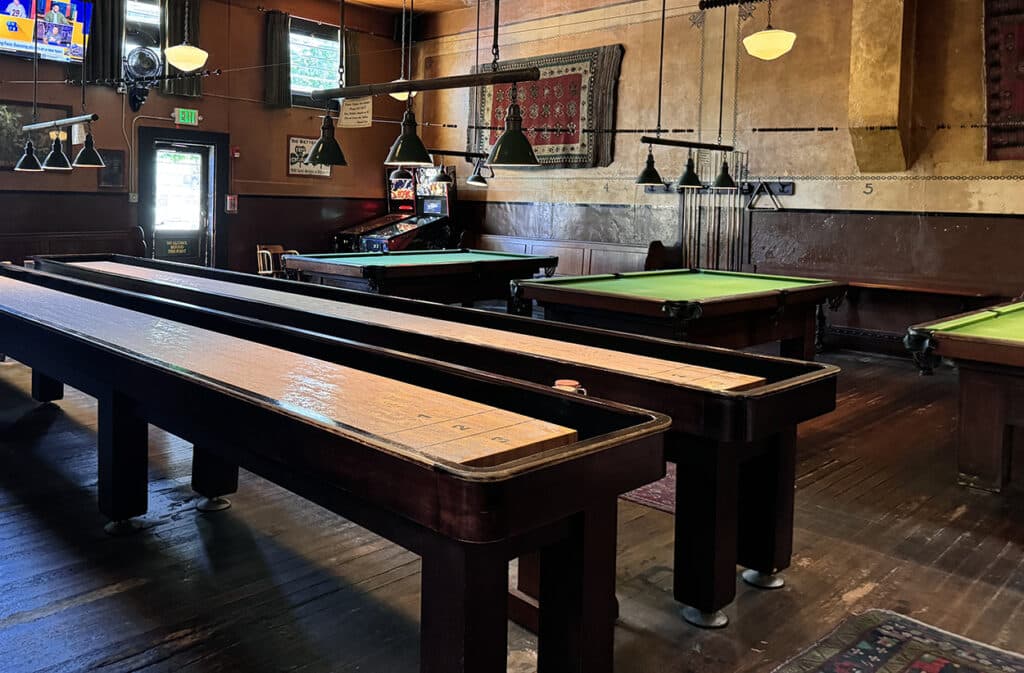
Pool tables in the Olympic Club in Centralia. Photo by Mary Williams
The movie house is known as the Olympic Club Theater. It was once a clothing store and billiards room. The theater is decorated with a tin ceiling, velvet couches, and various forms of art including photos of notorious guests.
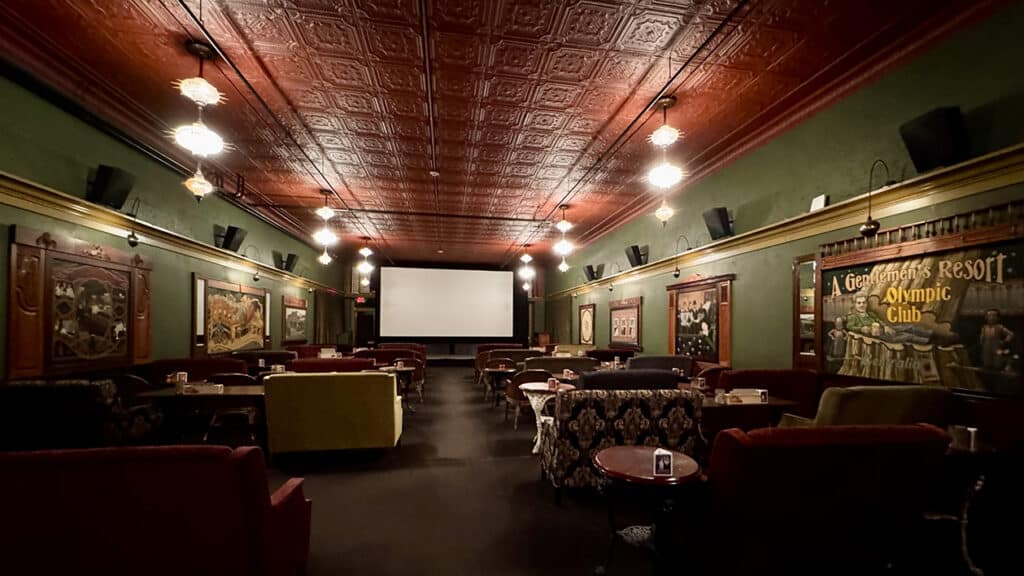
The theater at the Olympic Club in Centralia. Photo by Mary Williams
The 27 hotel rooms (once a brothel) are on the second floor above the bar and dining area. They are what’s known as “European-style” rooms without telephones, TV’s, or on suite bathrooms (yikes!). They are not accessible unless you’re a registered guest. When the hotel was remodeled and the plumbing modernized, many of the older fixtures were moved to areas on the first floor where they can be admired by the general public.
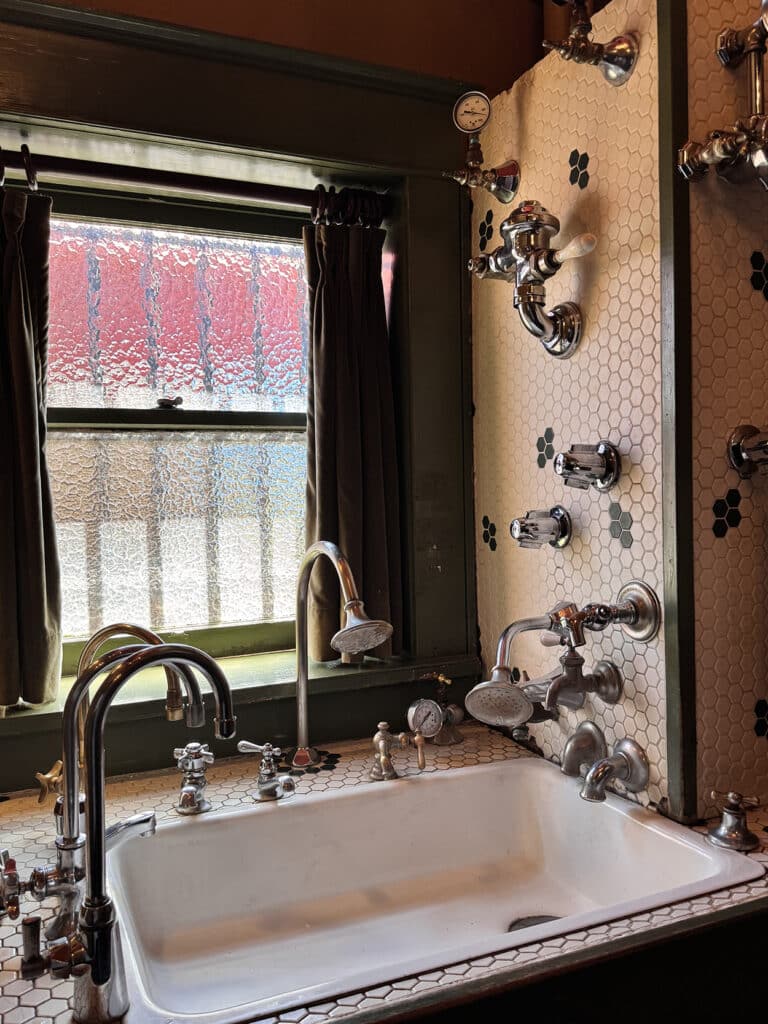
A shared bathroom in the Olympic Club in Centralia. Photo by Mary Williams
The basement is not open to the public either. It may at one time have been used for bootlegging and possibly contains tunnels leading to the historic Centralia Union Depot, which is just across Railroad Avenue.
Speaking of the Centralia Union Depot, if you were in Gig Harbor in 1980 when Mt. St. Helens blew, you might have been one of the lucky kids (or a parent of one of those kids) who got to participate in the annual Harbor Heights kindergarten train trip. I’m not sure when the tradition started, or how long it continued, but I know that for at least a few years it was the highlight of the year for the kindergarten class.
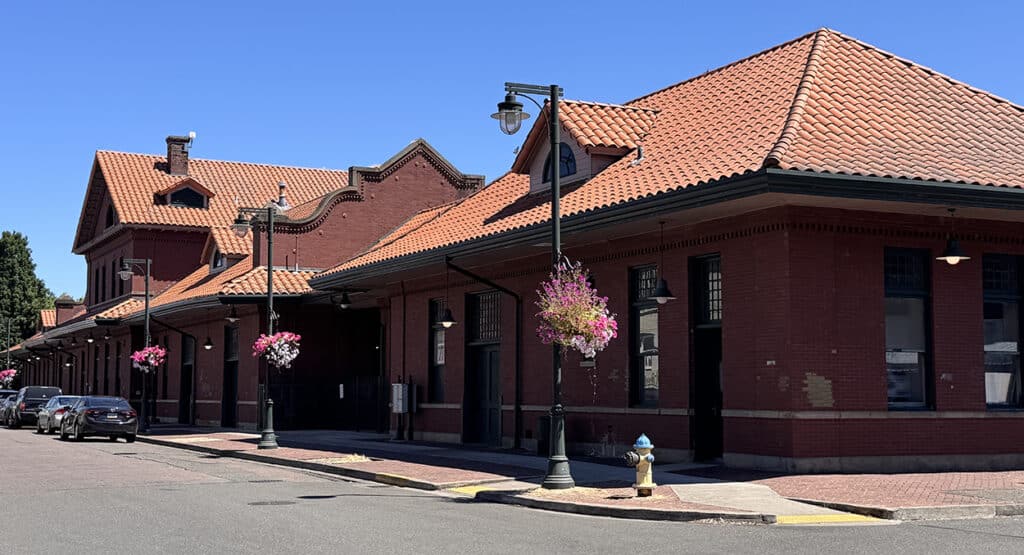
The Centralia Union Depot. Photo by Mary Williams
A school bus transported the kids, teacher (Mrs. Allen when my kids participated), and a few parents to the Amtrak station, where they boarded the train for the trip along the water to the Centralia Union Depot. After a two-block walk to George Washington Park, where a picnic lunch was consumed, everyone returned to the depot for the trip home via the afternoon train. Little did we know that our path took us past a brothel and speakeasy. Now that would have been a history lesson.
About the Day Tripper column
Gas prices are sky high, and a night in a hotel is approaching astronomically expensive. So, for the foreseeable future, I imagine many of you are going to find yourselves taking day trips rather than the road trip vacations we’ve grown to love.
This beautiful region in which we live is ripe with opportunities to explore new places, see new things, and learn a little something at the same time. I promise to keep the longest journeys to a one-way distance of under 200 miles. Whether you want to make it an overnight trip, a weekend, or just a very long day trip, we should be able to pull it off.
I hope you’ll grant me the honor of your virtual company as we travel these roads together. Happy trails!

